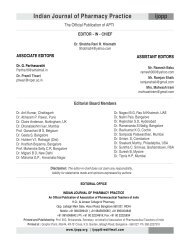Oct-Dec, 2011 - Indian Journal of Pharmacy Practice
Oct-Dec, 2011 - Indian Journal of Pharmacy Practice
Oct-Dec, 2011 - Indian Journal of Pharmacy Practice
- No tags were found...
You also want an ePaper? Increase the reach of your titles
YUMPU automatically turns print PDFs into web optimized ePapers that Google loves.
Dinesh KU - Evaluation <strong>of</strong> the Impact <strong>of</strong> a Pharmaceutical Care Program for Diabetes Patients in Nepal: A Preliminary Study2hypertension, hyperlipidemia and ischemic heart disease indiabetics also required to prescribe large number <strong>of</strong> drugs forthese patients life long. The long term complications can becontrolled only if the patient maintains their tight glycemic8control by following advice provided by healthcarepr<strong>of</strong>essionals. Pharmacist can play an important role in9patient counseling and education program <strong>of</strong> diabetics. Thepatients' satisfaction can be increased only if their healthrelated problems can be minimized by providing proper careto them by healthcare pr<strong>of</strong>essionals.Diabetes increase the economy burden and reduces patients'10productivity. Disease awareness in a population is the cornerstone to formulate the strategy to decrease the prevalence rate<strong>of</strong> diabetes. Organizing counseling and educational programis the first step to increase the awareness and alertness in thepatients for the disease and reduce the risk <strong>of</strong> long termcomplications. This may lead to less prescription cost andreduces the economy burden to the patient.A large number <strong>of</strong> research have been done in counseling and11,12education <strong>of</strong> diabetics. Proper counseling and educationcan improve patients knowledge about diabetes and increase13attitude and practice. Knowledge and information can helppeople to assess their risk <strong>of</strong> diabetes and inspire them to take14charge <strong>of</strong> their disease. A study from Kenya had identified aserious deficiency <strong>of</strong> knowledge about diabetes among the15diabetes patients. Another study from Nepal stated thatproper knowledge and care management program canimprove the patient outcomes and prevent the early stage <strong>of</strong>16complications. A study done from India stated that propercounseling and education improves patient's perceptions,17attitudes and practices regarding diabetes.Nepal is a developing country in South Asia with a significantburden <strong>of</strong> diabetes. It is estimated that the diabetes burden in18Nepal will be increased up to 6,38,000 by the year 2025. Thestrong reason behind increased percentage <strong>of</strong> diabetes inNepal is low literacy rate, lack <strong>of</strong> public awareness, lack <strong>of</strong>alertness and understanding for diabetes, lack <strong>of</strong> advancedhealthcare facilities, low socioeconomic status and sedentary5life style. These factors may increase the diabetes incidencein the country which may lead prescription overload and19irrational drug prescribing.Hence, this preliminary study was conducted to identify theimpact <strong>of</strong> pharmaceutical care program among diabetics andits effect on KAP outcomes, patients' glycemic control, drugprescribing pattern, and effect on patients' economy burdenand satisfaction.OBJECTIVES:The present study was carried out with the followingobjectives:1. To study the demographic details <strong>of</strong> newly diagnoseddiabetes patients enrolled in study.2. To evaluate the patients' knowledge, attitude and practiceabout diabetes.3. To study the pattern <strong>of</strong> drug prescribing among diabeticpatients.4. To study the impact <strong>of</strong> pharmaceutical care program onglycemic control <strong>of</strong> the study subjects.5. To study the direct cost incurred by diabetics in diabetesmanagement.6. To evaluate the patient satisfaction on the pharmaceuticalcare provided to them.METHODOLOGYStudy design: This study was a prospective, interventional,follow up study where the newly diagnosed diabetic patientsstwere enrolled in the study during their 1 day <strong>of</strong> hospital visitto the Medicine Department. The patients were divided intothree groups [Control group (CG), Test group-1(TG-1) andTest group-2 (TG-2)] on the basis <strong>of</strong> 1 to 1 enrollment method.The control group patients were on the normal care, while thetest group-1 and test group-2 patients were on pharmaceuticalcare apart from normal care given by the clinicians. Eachpatient was followed for two months during their treatmentschedule.Consent form: This form was prepared to get the writtenconsent from patients before enrolling them in the study. Thisform was prepared in English and translated into local Nepalilanguage.Study site: The study was carried out in medicationcounseling center (for out patients) and at the bed side forhospitalized patients in medicine ward, Manipal TeachingHospital (MTH), Phulbari, Pokhara, Nepal. MTH is an 825bedded multidisciplinary private tertiary care teachinghospital <strong>of</strong> Manipal College <strong>of</strong> Medical Sciences located inwestern region <strong>of</strong> Nepal with average bed occupancy <strong>of</strong> about250 patients and an average out patient flow <strong>of</strong> about 450 perday. The hospital consists <strong>of</strong> both clinical and non-clinicalspecialty departments. Manipal College <strong>of</strong> Medical Sciencesthhas been included in the 7 WHO lists <strong>of</strong> hospitals in thedeveloping world. The hospital provides healthcare service topatients <strong>of</strong> western and mid western region <strong>of</strong> Nepal.Study duration: This preliminary study was carried out forthe duration <strong>of</strong> six months from February 2009 to July 2009 atManipal Teaching Hospital.<strong>Indian</strong> <strong>Journal</strong> <strong>of</strong> <strong>Pharmacy</strong> <strong>Practice</strong> Volume 4 Issue 4 <strong>Oct</strong> - <strong>Dec</strong>, <strong>2011</strong> 50
















